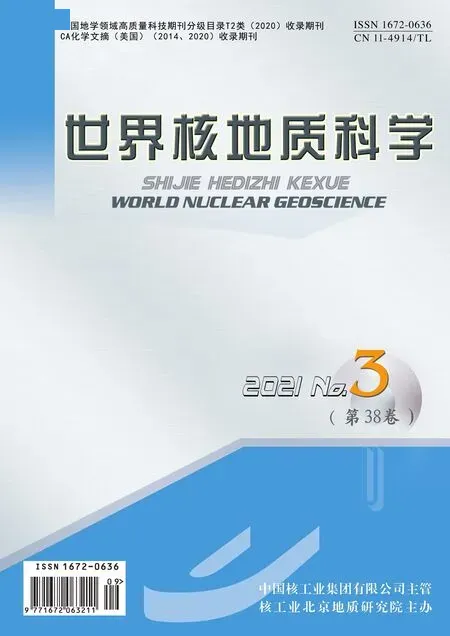大数据时代矿床学研究发展状况综述
路英川,李 鹏,王 浩,张 翔,汤宇磊,谢 亘
大数据时代矿床学研究发展状况综述
路英川1,李 鹏1,王 浩1,张 翔1,汤宇磊1,谢 亘2
(1. 中国地质调查局地球物理调查中心,河北 廊坊 065000;2. 中国地质调查局廊坊自然资源综合调查中心,河北 廊坊 065000)
近年来矿床学的研究出现了如成矿模式创新性不足以及成矿系列与成矿规律视角单一等瓶颈。回顾矿床学的发展历程表明,矿床学研究的每一次突破和飞跃,都与新科学技术的发展息息相关。随着“大数据”“智能化”时代的来临,人工智能大数据深度学习等新技术正在蓬勃发展。地质数据具有“大数据”的大量性、高速性、多样性和价值性的“4V”的特征,还有多元性、多维性、多源性、异构性、时空性等特点。通过对近十余年国内外相关文献的统计对比分析,对人工智能、机器学习、深度学习等之间的从属关系和主要特征进行了阐述,对随机森林算法、卷积神经网络、决策树算法、朴素贝叶斯和支持向量机等算法在矿床研究中的实例进行了梳理,认为人工智能技术引领全球矿产资源智能勘查研究将成为矿床学研究发展的必然方向。
矿床学;成矿模式;大数据;机器学习;人工智能
随着生产力的不断发展,矿产资源已经逐渐成为人类社会赖以生存和发展的基础,矿床学研究也经历一个历史发展过程。人们早期依赖肉眼观察,主要对单一矿种和单一矿床进行描述性观测研究、伴随地球化学、地球物理、遥感影像等技术的普遍应用,特别是板块学说的引入以及相关“成矿模式”、“成矿体系”等概念的提出,极大地提高了多种矿床成矿作用与成矿机制的科学研究水平,也使超大型矿床理论研究取得了不菲的成就[1]。
20世纪40年代以来,Warren McCulloch和Walter Pitts (1943) 便对人工智能进行了尝试性探索,第一次提出人工神经元的数学模型[2];此后,Donald Hebb (1949)、Rosenblatt (1958)、Minsky和Papert(1969)以及Rumelhar和Hinton (1986) 等学者为人工智能技术的发展奠定了基础[3-6]。Mayer-Schønhberger Viktor和Cukier Kenneth率先提出了互联网信息“大数据”的概念[7],并在2013年将《大数据时代》这一重要著作呈现到人们面前[8],初步阐述了利用“大数据”分析处理取代随机分析法,从而也可为矿床学的研究提供新的机遇。
地球科学与人工神经网络从双轨并行到交叉融合的时代已悄然而至。笔者简要总结了矿床学发展概况,提出矿床研究中存在的成矿模式难以创新、成矿系列与成矿规律视角单一等问题,并总结地质数据具备大量性、高速性、多样性、价值性的“大数据”特点和机器学习的常用算法。希望能引发读者对大数据与地质学,特别是人工智能技术下矿床学研究发展方向的思考。
1 矿床学研究发展概况
矿床学是研究矿床成因,揭露成矿规律,引导矿产勘查的一门地质学分支学科。矿床学以“探讨成矿机制,指导找矿勘查”为学科使命,与矿物学、岩石学、地球化学、构造地质学等学科一脉相承[9]。地质研究者每次研究思路的改变,将很大程度促进矿床学的发展。概括来讲,矿床学的研究思路经历了从单一矿种、单一矿床的局部研究到对成矿系列、成矿系统的整体认识过程[10]。
20世纪初期,矿床学的研究还只是局限于矿床地质的探讨、成矿热液的来源、矿田构造的展布以及矿床成因的揭露等方面;至20世纪中后期,伴随着同位素技术的引进以及板块理论的普及,极大提高了矿床学研究的科学理论水平,并衍生出诸如板块构造与成矿、同位素年代学以及矿床地球化学等多个分支学科;20世纪80年代以后,关于超大型矿床、海底热液成矿、以及地幔柱与成矿的报道纷至沓来[10-13],矿床学的发展也进入了一个全新的阶段。
自从成矿系列的概念被首次提出以来,距今已有百年的研究历史[10]。成矿系列突破了对矿床的单体研究的局限,更加注重区域地质背景和环境与成矿作用之间的关系,将地质研究者引向了多矿种共生和多类型矿床共生的广阔视野中来[10]。“成矿系统”理论则统筹了矿床发生-形成-保存-破坏等演化历史与空间分布的统一性,不但进一步拓宽了矿床学研究的方向[12],也完美诠释了成矿系统与成矿系列的关系[14]。地质学者们通过对成矿系统的深入研究,取得了丰硕的研究成果[12,15-20]。
探索成矿机制并建立成矿模式一直以来就是矿床学研究的首要任务,也是指导找矿勘查的理论基础[9, 21]。通过矿床和成矿带两种尺度均可建立相应的成矿模式:前者一般是通过对构造岩浆控矿、成矿流体演化、矿床地质特征等内容的研究来限定成矿动力、物质来源和成矿过程[9];后者则多集中于不同矿床地质和地球化学特征之间的对比,从而得出区域成矿模式并指导矿产勘查[9,21]。
同时,矿床勘查方法的革新,观测手段和测试方法的改进,推动了矿床成矿元素的赋存状态和富集机制研究成果的不断涌现。
2 矿床学研究中面临的挑战
矿床学的发展历程并不是一路平坦,在各个历史时期都遇到过或大或小的瓶颈。每次瓶颈期的出现,都与当时其他学科的科技水平息息相关。矿床学的每一次突破和飞跃,也与新科学技术的发展相互联系。进入21世纪特别是近十几年以来,矿床学研究正面临着空前严峻的挑战。随着全球及中国社会发展进入新的阶段,囿于传统科学技术的限制,发现新矿床的难度也与日俱增,保持矿产资源持续供应问题正在逐年加剧,这些挑战不但涵盖了学科发展前沿,也涵盖了国家战略布局以及社会发展重大需求等诸多领域[9]。成矿模式创新研究不足、学科交叉融合程度不够以及应用基础研究相对薄弱等方面是制约学科发展的主要方面。
2.1 成矿模式难以创新
成矿模式是对成矿作用的地质条件、控矿要素、地质过程、成矿机理和构造背景的高度概括,既来源于找矿实践,又指导找矿实践[1]。
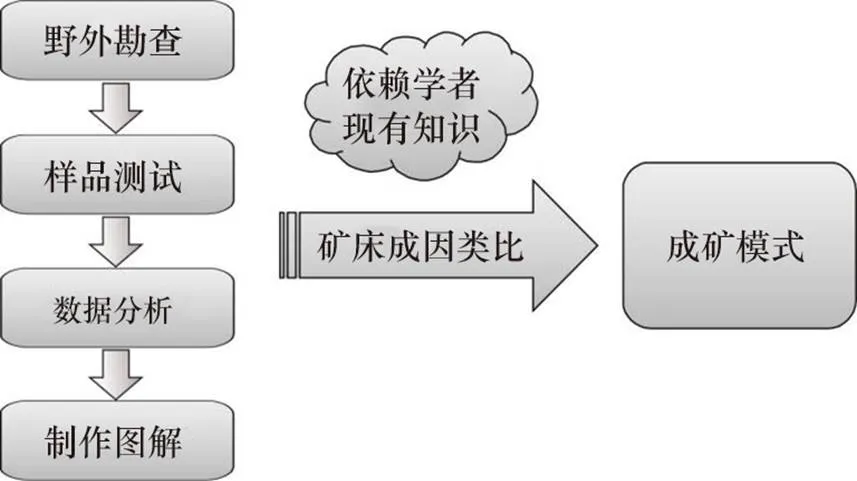
图1 传统成矿模式建立流程
成矿模式的建立工作在21世纪初达到高峰,部分学者对中国主要矿床类型的矿床模式(模型)也进行了详细的总结[1,22]。传统矿床研究和成矿模式的建立过程虽然较多,但是概括来讲一般包括野外数据采集→岩石样品测试→数据分析→图解制作→矿床成因类比→成矿模式建立等6个步骤(图1)。基本可以划分为数据获取和归纳演绎两大阶段:如野外描述、产状测量、矿体编录,乃至矿石分析测试、储量计算等均属于数据获取阶段;而对数据的归纳演绎、对比模拟、揭露成矿背景、构建成矿模式、分析成矿系统、预测指导找矿等均属于归纳演绎阶段(表1)。两个阶段的工作手段的主观性和客观性不尽相同,有的工作手段兼有主观与客观两种特性。如果把“主观”、“主观+客观”以及“客观”分别赋值为1、2、3,便可得到图2的直观表达。
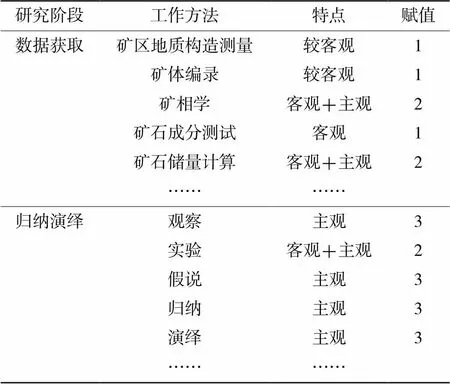
表1 矿床学研究阶段划分
在成矿模式建立的过程中,尤其是矿床成因类比阶段,主要依赖地质工作者现有的知识水平来完成(图1),所以传统成矿模式的建立,虽同一矿床,因地质工作者们的知识水平和对问题的理解角度不同而千差万别,甚至互相矛盾。

图 2 矿床研究方法主客观因素直观图
近年来,有关新的成矿模式问世的理论创新报道相对减少[9],主要是围绕已有成矿模式作进一步的精细化工作(表2)。以研究程度较为成熟的斑岩型铜矿床为例,广大学者对斑岩型铜矿的成因机制存有俯冲与碰撞两种不同构造背景的成矿体系解释[23-24],尤其是对于成矿物质来源、成矿过程、保存条件及宏观控矿要素的确定等问题的研究还不够成熟。众所周知,加强对这些方面的深入研究必会有效推动斑岩铜矿成矿模式的创新进程[9],但是基于传统的思维方式和算法手段的限制,欲实现这一目标尚有较大的阻力。
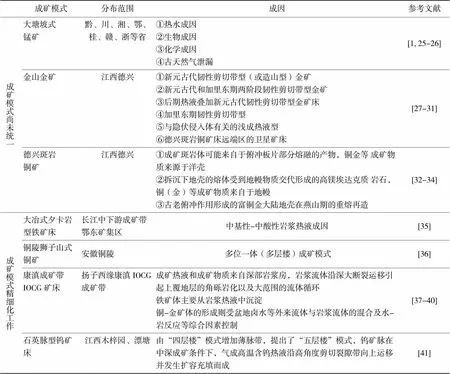
表 2 典型传统成矿模式的研究特点
几十年来,矿床学的研究总体上偏向对成矿理论,特别是成矿机制和模式创新的精细化基础类研究,而缺乏将成矿机制与勘查指示紧密结合的应用研究[9]。一直以来,国内、外均十分重视矿产勘查手段的改进和勘查效率的提升,但伴随着更多的勘查技术和勘查方法的投入使用,勘查投入的成本也节节攀升。近年来我国地勘界也致力于“快速勘查方法体系”的研究开发,但实际效果却并不十分明显[9]。
进入21世纪后,各种先进的实验分析技术蓬勃发展,有力支撑了矿床成因的研究,虽然较为丰富了成矿理论系统创新成果,深刻揭示了地幔柱活动[42-44]、多块体拼合[45]、克拉通破坏[46-49]、大陆裂谷作用[50-51]、板块俯冲[52-53]、大陆碰撞[54-56]等重大地质事件与大规模成矿作用的耦合关系,并在大陆动力学成矿[58]、大面积低温成矿作用[59]等重大科学问题,产生了重要的国际影响[1],但是受传统技术和思维方式的限制,研究者只能基于抽样调查的手段建立各种类型的成矿模式,对成矿规律难以形成更深度的把握。
对于成矿模式的指导矿产勘查工作,首先应加强对矿床研究的准确化和精细化解剖,从而进一步校正已有的成矿模式,并为发现和建立新的成矿模式提供可能。因此,要求研究者们能突破传统思维禁锢,围绕成矿机制多维探索,深刻揭露矿床成因的内在规律,实现原有成矿模式的再创新,完善矿床学成矿理论研究的科学性和对矿床实体认识的客观性。
2.2 成矿系列与成矿规律视角单一
20世纪70年代,程裕淇、陈毓川、赵一鸣等在系统研究全国铁矿成矿规律的基础上,率先提出“铁矿成矿系列”和“矿床成矿系列”的概念[60],使成矿系列成为之后20多年国内矿床学研究的前沿课题[1]。对成矿系列和成矿体系的深入研究,有助于在宏观视野揭露成矿规律,对指导矿产勘查工作有十分重要的意义。在研究成矿系列时间与空间结构基础上,发现了成矿系列的概况性、共同性、分带性、重叠性、有序性、互补性和预见性等特点[61]。
与单个矿床的成因揭示不同,成矿体系与成矿规律的研究更需要应用“大数据”理念,以“全息”式研究补充和完善传统的“抽样调查”的不足,以全新的视角揭露成矿系列和成矿规律[7]。
在传统的成矿系列和成矿规律研究过程中,虽然广大研究者们坚持秉持严密逻辑的思维过程,根据掌握的各类地质资料,通过各种传统的计算方法进行建立并在指导找矿中进行补充和完善,由于各人所掌握的数据类型有限,工作经历不同,对客观问题的认识千差万别,且以往的工作中缺少一套规范性的技术要求[62],所以对成矿系列和成矿规律的归纳总结上存在视角单一、思维受限的弊端,在对数据利用和深度挖掘上存在一定的技术瓶颈,难免在成矿预测中做出主观的估计和偏离实际的推断。
3 大数据时代矿床学研究及展望
“大数据”具有Volume(大量)、Velocity(高速)、Variety(多样)和Value(价值)的特点[7-8],地质数据便符合这“4V”特点。传统的主流方法虽然也有数理统计学和数据库管理等手段,但是在大数据特别是超算技术的应用,大数据挖掘、机器学习技术逐渐成为众多学者关注的热点[63-64]。
3.1 地质数据体量丰富
随着各种地球化学理论与方法在矿床学研究中的广泛应用,极大地提高了人们对矿床成因和成矿机制的认识,不断地丰富和完善成矿理论体系[9]。各类地质数据的采集和挖掘都与信息社会的“大数据”不谋而合[7];矿床学研究经过百余年的探索发展,尤其是20世纪70年代以来,元素地球化学[65-70]、同位素地球化学[71-74]、流体包裹体研究[75-78]、成矿年代学[79-81]、矿田构造解析[82]以及成矿实验方法[52, 83]等技术手段的广泛应用,使得矿床学研究方法不断成熟和丰富,形成了庞大的数据集合。
当前我国地质学科已呈现数据密集型的大数据特点,而且每年仍以较高的速度产生,种类也不断趋于完整丰富。网络世界中通过各种模型所计算出来的数据比重也许正在被地质工作实测的“实体”数据的比重所超越[7]。地学各个专业都在建立和规范管理各专业子领域的数据资源[7],虽然地质原始数据已经基本实现了海量积累,但是矿产资源综合利用程度依然偏低,随着地质找矿难度日益增大,如果不利用现代“大数据”新技术对其进行深度挖掘和关联研究,将造成现有庞大数据资源的浪费。
3.2 地质大数据特征
地质大数据具有“大数据”的大量性、高速性、多样性和价值性的“4V”特征。
大量性:当前的地质数据是一个庞大的数据集合,包括地、矿、物、化、遥等各个领域[7]。2015年以来,中国地质调查局系统不但建成区域地质数据库、基础地质数据库、矿产资源数据库、油气能源数据库,还建成了钻探、遥感调查、地球物理、地球化学、水工环灾害、资料文献和专题专项等十余个数据库,且数据库的种类以及数据都在不断的充实与完善[7]。
高速性:由于新的探测技术或新的测试方法的引进与运用,地质数据的产生速度正在以成倍甚至几何级数的速度累积增高,航空遥感、航空物探和区域地球化学等领域尤为显著[7]。
多样性:地质数据从原始信号、原始数据到文字、图像、音频等结构化与非结构化数据类型无所不包。
价值性:大量的地质数据,尤其是矿产或物化探异常信息等数据,具有较大的经济潜在价值。
除此之外,地质数据还具有多元性、多维性、多源性、异构性、时空性、方向性、相关性、随机性、模糊性、时空不均匀性和过程的非线性等特点[84]。
3.3 机器学习
近年来,人工智能各类算法已日趋成熟,深度学习(Deep Learning,DL)已经在图像分析[85]和语音识别[86]领域得到广泛应用,在自然语言处理[87]乃至视频分类[88]等方面取得了令人瞩目的成绩。
由于机器学习的概念在生活中刚刚流行,所以很多人对专有名词和概念尚较为模糊,对于人工智能、机器学习、深度学习等之间的从属关系也不甚清楚。
机器学习(Machine Learning)是指用某些算法指导计算机利用已知数据得出适当的模型,并利用此模型对新的情境给出判断的过程[64],通常分为有监督学习(Supervised Learning)和无监督学习(Unsupervised Learning)。有监督学习又可分为分类(Classification)和回归(Regression)两类。其中分类算法包括:朴素贝叶斯算法、决策树算法、Logistics回归、临近算法和支持向量机算法等;回归算法包括:线性回归和多项式回归等。无监督学习通常可分为聚类(Clustering)、降维(Dimensionality Reduction)和关联规则学习(Association rule learning)等算法。其中均值聚类、Mean-Shift、DBSCAN、支持向量机等属于聚类算法范畴;主成分分析、奇异值分解、潜在狄里克雷特分配、潜在语义分析以及t-SEN等属于降维算法范畴;Apriori、Euclat、EP-growth属于关联规则学习的范畴。神经网络学习是机器学习的子集,深度学习(多层神经网络)又是神经网络学习的子集(图 3)。
学习的学习过程是一种对于有效特征的抽取过程(图4)。深度学习的训练模型往往需要海量数据作为支撑[64]。深度神经网络可在不须输入和输出之间精确的数学表达式的情况下自动提取二者之间的映射关系[89],所以使用深度神经网络既能提取状态特征,又易于训练[90]。
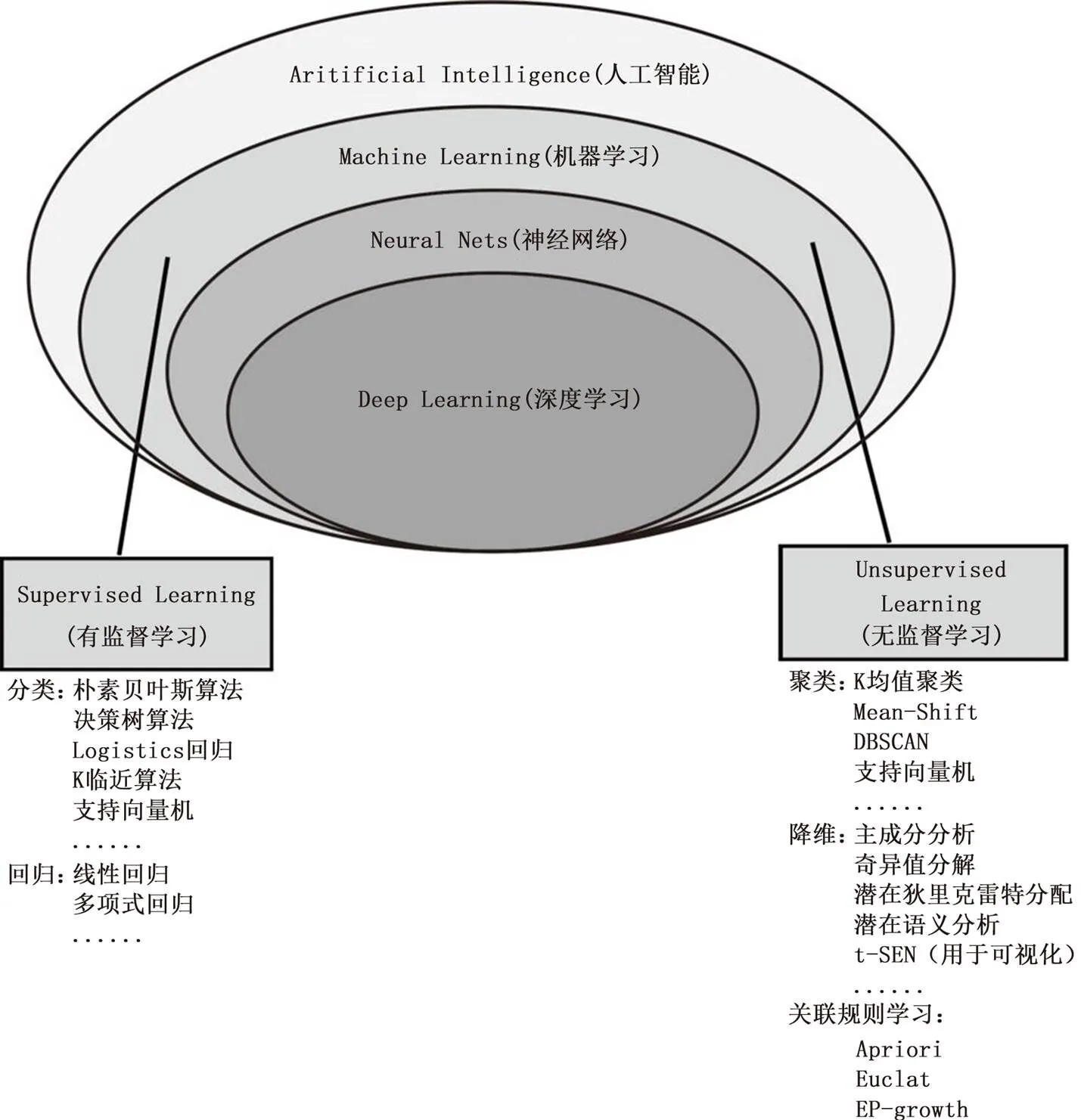
图 3 人工智能算法关系示意图
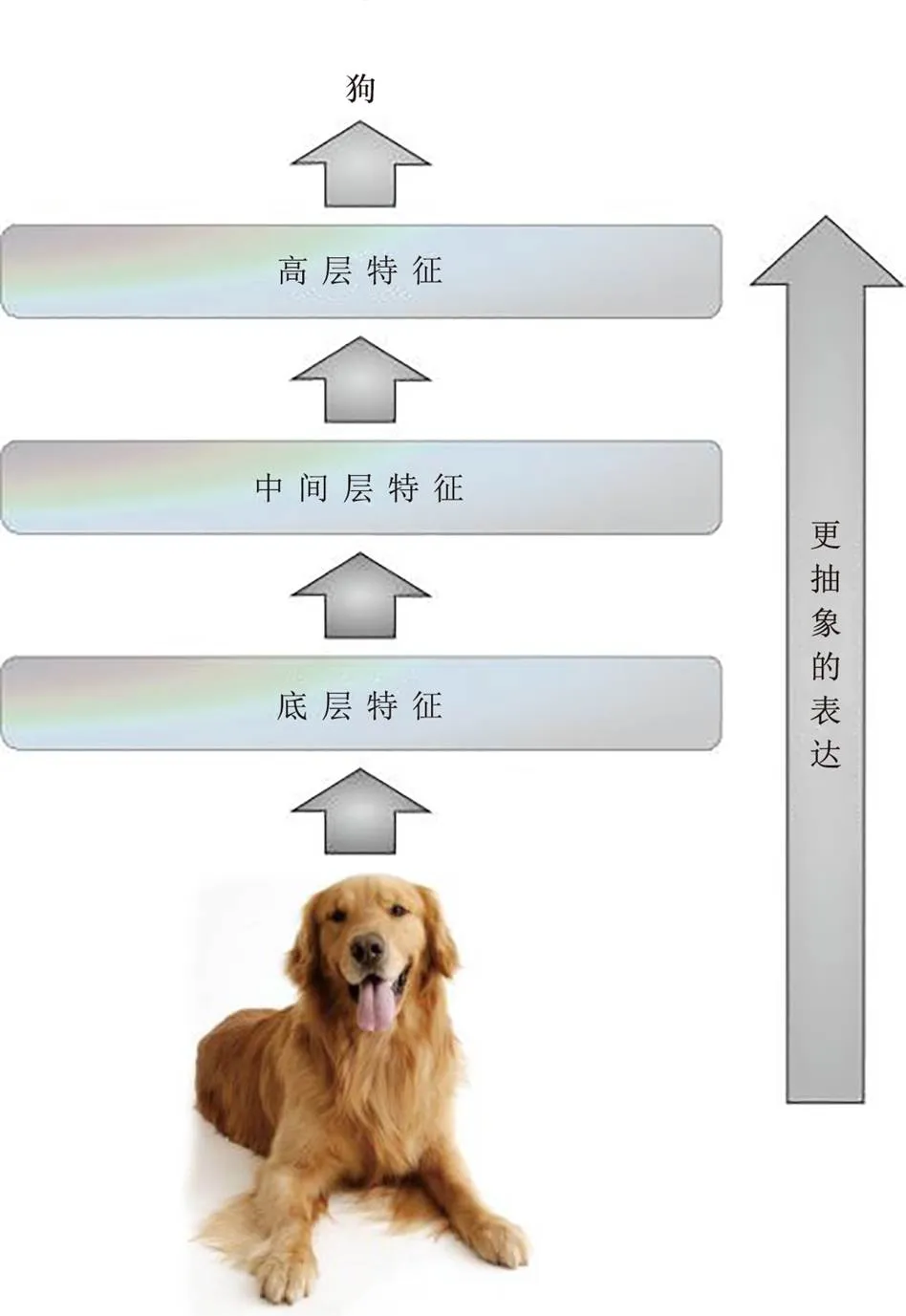
图4 深度学习的学习过程示意图(图片引自网络:https://www.tooopen.com/view/179052.html和https://www.zhihu.com/question/264417928,有改动)
Mnih,等(2013)提出的深度Q学习网络(Deep Q-network,DQN)算法,将卷积神经网络(Convolutional Neural Network,CNN)与强化学习(Reinforcement Learning,RL)中的经典算法Q学习算法结合起来[90-91],是目前最为常用的一种深度学习算法。在基于价值的深度强化学习方法中,深度神经网络被用来当作价值函数的逼近器,利用深度神经网络构成策略网络。将策略参数化表示拥有更好的收敛性,可以弥补在动作空间很大或动作为连续集的情况下DQN方法在解决机器人学问题时的局限性,更适用于高维连续空间的策略求解;多种结构的深度强化学习算法可以使算法在计算效率、样本利用率、计算资源上都有所提高[90]。如今卷积神经网络、深度Q学习网络、多种结构的深度强化学习、PILCO算法等,对人类社会的巨大影响已经在多个行业有明显的展现[92-97](表3)。
大数据挖掘特别适合于窥探具有多维性和全面性的现实世界,而高维数据处理是大数据深部挖掘的基础,它善于从支离破碎的信息中复原事物全貌[105]。图5表示利用数据挖掘领域中拓扑数据分析(Topological Data Analysis,TDA)不仅可以有效地捕捉高维数据空间的拓扑信息,还能够在不丢失高维的信息的前提下有效降低大规模数据处理的维度[106]。
3.4 矿床学研究的历史机遇
在最近几年,随着深地勘查需求的进一步加强,以大数据分析和数值模拟为代表的新一轮科技革新正在不断拓展着传统学科的理论认知领域[9]。利用人工智能深度学习技术对海量地质数据进行分析和计算,为深度探索隐藏在其背后的有价值的地质信息资源提供了可能。
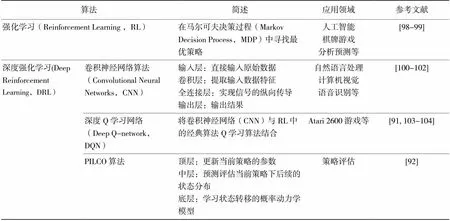
表 3 强化学习和深度强化学习部分算法列举表
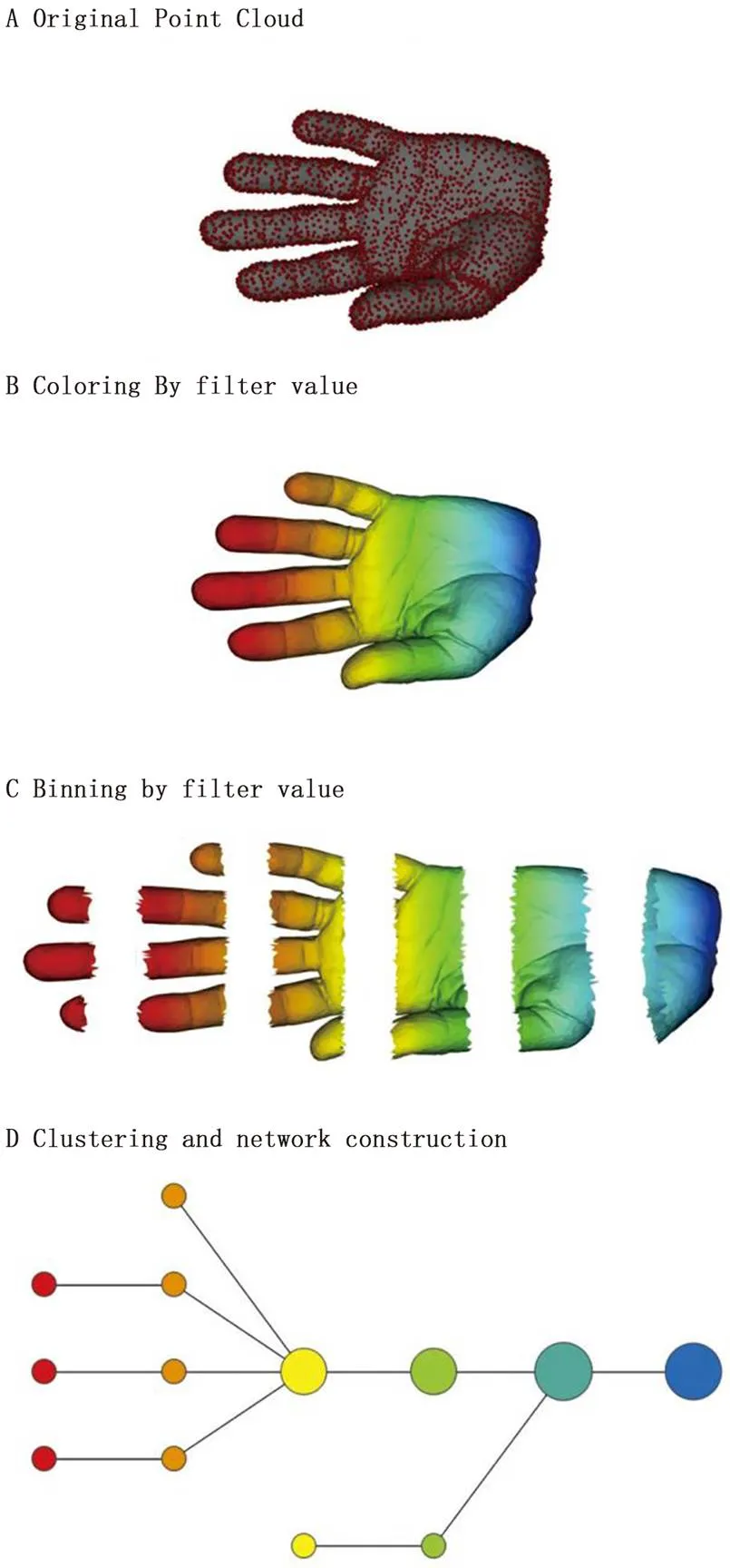
图5 拓扑数据分析示例(据参考文献[106])
大数据分析和机器学习等正逐步被应用到地学领域中来[107],并取得一些具有启发性的理论创新成果[108],如应用关联规则算法对与金矿相关的侵入岩、火山岩、变质岩建造及区域构造地质大数据的关联性的探索发现地质要素之间的共生关系[109];利用贝叶斯网络(Bayesian Network)揭示矿床的成因机制并构建大数据-智能矿床成矿与找矿模型等[110];利用大数据手段对特提斯斑岩成矿带、中亚斑岩成矿带和环太平洋斑岩成矿带进行地质地球化学对比分析,进而揭示地壳性质对斑岩铜矿控制作用等[111]。
最近,我国的很多学者正尝试利用机器学习方法对地质大数据进行深度挖掘,陈进等(2020)通过随机森林算法对大尹格庄金矿的三维矿体定位预测,圈定了7个三维找矿靶区,取得了较好的效果[112];刘艳鹏等(2020)如通过卷积神经网络方法挖掘元素Zn在地表的分布特征与矿体在地下空间就位的耦合关系,得到了准确率为95%的CNN模型[113];闫岩等(2021)利用数据信息搭建变质程度-矿物网络模型,揭露绿片岩相和麻粒岩相对金属矿床和非金属矿床的控制关系,较好的证明了数据挖掘方法有效性[114];张振杰等(2021)利用决策树算法、神经网络、朴素贝叶斯和支持向量机等算法对闽西南马坑式铁矿进行成矿预测,四种方法均取得了较好的预测效果[115]。此外,基于多主题数据集成开展矿床三维可视化建模[116]、智能技术集成算法对非线性地球化学特征进行精细化信息识别与预测预判[117]、随机森林算法对磁铁矿主微量元素在矿床成因分类中的重要性排序[118]以及利用成本敏感神经网络预测铁多金属远景[119]等研究也相继报道。
大数据时代给矿床学研究的发展带来了新的启迪,但是在实际操作过程中也面临着许多亟待解决的科学问题。如在矿床研究中利用地物化遥探测技术获取各种原始数据具有结构化、半结构化和非结构化特征[120],如此对地质数据的储存管理技术则提出了更高的要求。又如地质体、地质结构和地质过程的复杂性、不可见性和数据采集的抽样方式,导致出现“结构”“关系”“参数”“演化”等信息不全的状况,需要对地质数据进行三维、动态、多尺度、多细节层次的可视化建模技术提出更高的要求[120-121]。再如矿床大数据的多参数、多时态、多模态、多尺度以及不确定性特征,对基于全体数据的数据挖掘技术的运用还需要进一步的尝试。
目前,人工智能在矿床学中的相关研究还相对较少。对于利用人工智能进行矿床大数据深部挖掘,成矿模式建立和高效勘查的研究工作还处于起步阶段,当前尚未利用大数据手段对不同种类的矿床类型特征开展广泛研究,而对用于进行机器学习的数据平台也未能进行严格筛选,因而导致部分大数据手段和人工智能方法在地质学研究中所取得的效果不佳也在所难免,要实现“智能高效勘查”的要求还需继续努力。
构建地球科学大数据挖掘与机器学习的基本框架,运用机器学习关联规则算法[84]、高维数据降维[122-125]、推荐系统算法[64]、大图形社区结构识别[105]、人工智能地质学的建模[107]、分类与预测[126]及流数据处理[127-128]等技术,对已有矿产勘查方法与成矿模式进行深度挖掘并提炼勘查标识体系,从技术上弥补“无法用常规软件进行数据管理”[7]的不足已成为可能。
4 结论
1)进入21世纪特别是近十几年以来,矿床学研究正面临着空前严峻的挑战,囿于传统科学技术的限制,发现新矿床的难度也与日俱增。成矿模式创新研究不足、学科交叉融合程度不够以及应用基础研究相对薄弱等方面是制约学科发展的主要方面。
2)传统矿床研究和成矿模式的建立一般包括野外数据采集→岩石样品测试→数据分析→图解制作→矿床成因类比→成矿模式建立等6个步骤,基本可以划分为数据获取和归纳演绎两大阶段。在传统成矿模式建立的过程中,尤其是矿床成因类比阶段,主要依赖地质工作者现有的知识水平来完成,虽同一矿床,因研究者们的知识水平和对问题的理解角度不同而千差万别,甚至互相矛盾。
3)当前地学各个专业都在建立和规范管理各专业子领域的数据资源,地质学科已呈现数据密集型的大数据(4V)特点,而且每年仍以较高的速度产生,但是矿产资源综合利用程度依然偏低。
4)机器学习通常分为有监督学习和无监督学习。有监督学习又可分为分类和回归两类。无监督学习通常可分为聚类、降维和关联规则学习等算法。利用人工智能深度学习技术对海量地质数据进行分析和计算,为深度探索隐藏在其背后的有价值的地质信息资源提供了可能。
5)当前,我国部分学者通过机器学习方法在地质大数据深度挖掘方面的研究工作已经开展了尝试,并取得了一定的成效。构建地球科学大数据挖掘与机器学习的基本框架,运用机器学习关联规则算法、高维数据降维、推荐系统算法、大图形社区结构识别、人工智能地质学的建模、分类与预测及流数据处理等技术,对已有矿产勘查方法与成矿模式进行深度挖掘并提炼勘查标识体系,从技术上弥补“无法用常规软件进行数据管理”的不足已成为可能。
[1] 李建威,赵新福,邓晓东,等.新中国成立以来中国矿床学研究若干重要进展[J].中国科学:地球科学,2019,49(11):1720-1771.
LI Jianwei, ZHAO Xinfu, DENG Xiaodong, et al. An overview of the advance on the study of China’s ore deposits during the last seventy years[J]. Scientia Sinica Terrae, 2019, 49 (11): 1720–1771.
[2] McCulloch Warren S, Pitts Walter. A Logical Calculus of the Ideas Immanent in Nervous Activity[J]. Bulletin of Mathematical Biophysics, 1943 (5): 115-133.
[3] Hebb D O. The Organization of Behavior[M]. New York: Wiley, 1949.
[4] Rosenblatt F. The perceptron: A probabilistic model for information storage and orgnization in the brain[J]. Psychological Review, 1958 (65): 388-408.
[5] Minsky M, Papert S. Perceptrons[M]. Cambridge: MIT Press, 1969.
[6] Rumelhart D E, Hinton G E, Williams R J. Learning representations by back-propagaing errors[J]. Nature, 1986 (323): 533-536.
[7] 王登红,刘新星,刘丽君.地质大数据的特点及其在成矿规律、成矿系列研究中的应[J].矿床地质,2015,34(6):1143-1154.
WANG Denghong, LIU Xinxing, LIU Lijun. Characteristics of Big Geodata and its application to study of minerogenetic regularity and minerogenetic series[J]. Mineral Deposits, 2015, 34 (6): 1143-1154.
[8] Mayer-Schønhberger V, Cukier K. Big Data: A revolution that will transform how we live, work and think[M]. New York: Houghton Mifflin Harcourt Publishing Company, 2013, 1-158.
[9] 陈华勇.对我国矿床学未来发展方向的思考[J].地学前缘,2020,27(2):99-105.
CHEN Huayong. Meditations on the future development of ore deposit science in China[J]. Earth Science Frontiers, 2020, 27 (2): 99-105.
[10] 罗雪,曹新志.矿床学研究思路的变化与进展综述[J]. 地质找矿论丛,2010,25(2):147-152.
LUO Xue, CAO Xinzhi. Review on the change and development of the research thoughts about mineral deposit geology[J]. Contributions to Geology and Mineral Resources Research, 2010, 25 (2): 147-152.
[11] 袁见齐,朱上庆,翟裕生.矿床学[M].北京:地质出版社,1985: 1-346.
YUAN Jianqi, ZHU Shangqing, ZHAI YuSheng. Mineral Deposits[M]. Beijing: Geological Publishing House, 1985: 1-346.
[12] 翟裕生.关于矿床学研究前景的探讨[J].矿床地质,1999,18(2):146-152.
ZHAI Yusheng. A discussion on the geology of ore deposits[J]. Mineral Deposits, 1999a, 18 (2): 146-152 .
[13] 薛春纪,祁思敬,隗合明.基础矿床学[M].北京:地质出版社,2006: 1-27.
XUE Chunji, QI Sijing, WEI Heming. Essentials of Mineral Deposits[M]. Beijing: Geological Publishing House, 2006: 1-27.
[14] Grilhaumou N. Characterization of hydrocarbon fluid inclusions by infrared fluorescence microscopetrometry[J]. Mineralogical Magazine, 1990, 54: 519-533.
[15] 关广岳.成矿动力系统的定态与失定[J].东北大学学报,1994,15(1):20-23.
GUAN Guangyue. Steady and unsteady in dynamic systems of mineralization[J]. Journal of Northeastern University, 1994, 15(1): 20-23.
[16] 李人澍.成矿系统分析的理论与实践[M].北京:地质出版社,1996: 1-262.
LI Renshu. Theory and practice of metallogenic system analysis[M]. Beijing: Geological Publishing House, 1996: 1-262.
[17] 李人澍,朱华平.成矿系统的结构与聚矿功能[J].地学前缘,1999,6(1):103-113.
LI Renshu, ZHU Huaping. System structure and ore-forming function[J]. Earth Science Frontiers, 1999, 6(1): 103-113.
[18] 侯增谦,李红阳.试论幔柱构造与成矿系统:以三江特提斯成矿域为例[J].矿床地质,1998,17(2):9-113.
HOU Zengqian, LI Hongyang. A tentative discussion on the mantle plume tectonics and metallogenic system as exemplified by the Sanjiang tethyan metallogenic domain[J]. Mineral Deposits, 1998, 17 (2): 9-113.
[19] 翟裕生.论成矿系统[J].地学前缘,1999,6(1):12-27.
ZHAI Yusheng. On the metallogenic system [J]. Earth Science Frontiers, 1999, 6(1): 12-27.
[20] 翟裕生.成矿系统研究与找矿[J].地质调查与研究,2003,26(2):65-71.
ZHAI Yusheng. Research on metallogenic system[J]. Geological Survey and Research, 2003, 26(2): 65-71.
[21] 范永香,阳正熙.成矿规律与成矿预测[M]. 徐州:中国矿业大学出版社,2005: 1-274.
FAN Yongxiang, YANG Zhengxi. Metallogenetic regularities and prediction[M].Xuzhou: China University of Mining and Technology Press, 2005: 1-274.
[22] 毛景文,张作衡,裴荣富. 中国矿床模型概论[M]. 北京:地质出版社,2012: 1-560.
MAO Jingwen, ZHANG Zuoheng, PEI Rongfu.Mineral deposit models in China[M]. Beijing: Geological Publishing House, 2012: 1-560.
[23] Sillitoe R H. Porphyry copper systems[J]. Economic Geology, 2010, 105 (1): 3-41.
[24] 侯增谦,郑远川,杨志明,等. 大陆碰撞成矿作用:I. 冈底斯新生代斑岩成矿系统[J]. 矿床地质,2012,(4):647-670.
HOU Zengqian, ZHENG Yuanchuan, YANG Zhiming, et al. Metallogenesis of continental collision setting: Part I. Gangdese Cenozoic porphyry Cu-Mo systems in Tibet[J]. Mineral Deposits, 2012, 31(4): 647-670.
[25] 周琦,杜远生,覃英. 古天然气渗漏沉积型锰矿床成矿系统与成矿模式:以黔湘渝毗邻区南华纪“大塘坡式”锰矿为例[J]. 矿床地质,2013,32:457-466.
ZHOU Qi, DU Yuansheng, TAN Ying. Ancient natural gas seepage sedimentary-type manganese metallogenic system and ore-forming model: a case study of Datangpo type manganese deposits formed in rift basin of Nanhua Period along Guizhou-Hunan-Chongqing border area [J]. Mineral Deposits, 2013, 32: 457-466.
[26] 周琦,杜远生,袁良军,等. 古天然气渗漏沉积型锰矿床找矿模型:以黔湘渝毗邻区南华纪“大塘坡式”锰矿为例[J]. 地质学报,2017,91:2285-2298.
ZHOU Qi, DU Yuansheng, YUAN Liangjun, et al. Exploration models of ancient natural gas seep sedimentary-type manganese ore deposit: a case study of the Nanhua period “Datangpo” type manganese ore in the conjunction area of Guizhou, Hunan and Chongqing[J]. Acta Geologica Sinica, 2017, 91: 2285-2298.
[27] ZHAO C, Ni P, Wang G G, et al. Geology, fluid inclusion, and isotope constraints on ore genesis of the Neoproterozoic Jinshan orogenic gold deposit, South China[J]. Geofluids, 2013, 13 (4): 506-527.
[28] 毛光周,华仁民,龙光明,等.江西金山金矿成矿时代探讨:来自石英流体包裹体Rb-Sr 年龄的证据.地质学报,2008,82(4):532-539.
MAO Guangzhou, HUA Renmin, LONG Guangming, et al. Discussion on the mineralogenetic epoch of the Jinshan gold deposit, Jiangxi Province: Based on the quartz fluids inclusion Rb-Sr dating. Acta Geologica Sinica, 2008, 82 (4): 532-539.
[29] 张金春.江西金山韧性剪切型金矿成矿地球化学研究[D].南京:南京大学,1994.
ZHANG Jinchun. Metallogenic and geochemistry of Jinshan ductile sheartype gold deposit, Jiangxi Province[D]. Nanjing: Nanjing University, 1994.
[30] 黄宏立,杨文思.赣东北金山金矿床的地质特征及矿床成因[J].地质找矿论丛,1990,5(2):29-39.
HUANG Hongli, YANG Wensi. Geological characteristics and genesis of Jinshan gold deposit in the northeastern Jiangxi Province[J]. Contributions to Geology and Mineral Resources Research, 1990, 5 (2): 29-39.
[31] XU D R, Deng T, Chi G X, et al. Gold mineralization in the Jiangnan Orogenic Belt of South China: Geological, geochemical and geochronological characteristics, ore deposit-type and geodynamic setting[J]. Ore Geology Reviews, 2017, 88: 565-618.
[32] WANG C Y, Zhou M F, Qi L. Chalcophile element geochemistry and petrogenesis of high-Ti and low-Ti magmas in the Permian Emeishan large igneous province, SW China[J]. Contrib Mineral Petrol, 2011, 161: 237-254.
[33] WANG Q, Xu J F, Jian P, et al. Petrogenesis of adakitic porphyries in an extensional tectonic setting, Dexing, South China: Implications for the genesis of porphyry copper mineralization[J]. Journal of Petrology, 2006, 47(1): 119-144.
[34] 王国光,倪培,赵超,等.德兴大型铜金矿集区的研究进展和成矿模式[J].岩石学报,2019,35(12):3644-3658.
WANG Guoguang, NI Pei, ZHAO Chao, et al. The research advances and genetic model of the giant Dexing Cu-Au ore cluster[J]. Acta Petrologica Sinica, 2019, 35 (12): 3644-3658
[35] 翟裕生,姚书振,林新多,等.长江中下游地区铁铜(金)成矿规律[M].北京:地质出版社.1992: 1-235.
ZHAI Yusheng, YAO Shuzhen, LIN Xinduo, et al. Regularities of Metallogenesis for Copper (Gold) Deposits in the Middle and Lower Reaches of the Yangtze River Area[M]. Beijing: Geological Publishing House, 1992: 1-235.
[36] 黄许陈,储国正.铜陵狮子山矿田多位一体(多层楼)模式[J].矿床地质,1993,3:221-230.
HUANG Xuchen, CHU Guozheng. Multistory metallogenic model of the Shizishan orefield in Tongling, Anhui Province[J]. Mineral Deposits, 1993, 3: 221-230.
[37] ZHAO X F, Zhou M F, Gao J F, et al. In situ Sr isotope analysis of apatite by LA-MC-ICPMS: Constraints on the evolution of ore fluids of the Yinachang Fe-Cu-REE deposit, Southwest China[J]. Miner Depos, 2015, 50: 871-884.
[38] LI X C, Zhao X F, Zhou M F, et al. Fluid inclusion and isotopic constraints on the origin of the Paleoproterozoic Yinachang Fe-Cu-(REE) Deposit, Southwest China[J]. Econ Geol, 2015, 110: 1339-1369.
[39] SU Z K, Zhao X F, Li X C, et al. Using elemental and boron isotopic compositions of tourmaline to trace fluid evolutions of IOCG systems: The worldclass Dahongshan Fe-Cu deposit in SW China[J]. Chem Geol, 2016, 441: 265-279.
[40] ZHAO X F, Zhou M F, Su Z K, et al. Geology, geochronology, and geochemistry of the Dahongshan Fe-Cu-(Au-Ag) deposit, Southwest China: Implications for the formation of iron oxide copper-gold deposits in intracratonic rift settings[J]. Econ Geol, 2017, 112: 603-628.
[41] 康永孚,苗树屏,李崇佑,等.中国矿床编委会编《中国矿床》中册:中国钨矿床[M].北京:地质出版社,1994: 1-104.
KANG Yongfu, MIAO Shuping, LI Chongyou, et al. China Mineral Deposits Editorial Committee, China Mineral Deposits, Volume Ⅱ (Tungsten ore deposits in China)[M]. Beijing: Geological Publishing House, 1994: 1-104.
[42] Cao J, Wang C Y, Xu Y G, et al. Triggers on sulfide saturation in Fe-Ti oxide-bearing, maficultramafic layered intrusions in the Tarim large igneous province, NW China[J]. Miner Depos, 2017, 52: 471-494.
[43] Wang C Y, Wei B, Zhou M F, et al. A synthesis of magmatic Ni-Cu-(PGE) sulfide deposits in the ~260 Ma Emeishan large igneous province, SW China and northern Vietnam[J]. Journal of Asian Earth Sciences, 2018, 154: 162-186.
[44] Zhang D Y, Zhang Z C, Huang H, et al. Petrogenesis and metallogenesis of the Wajilitag and Puchang Fe-Tioxide-rich intrusive complexes, orthwestern Tarim Large Igneous Province[J]. Lithos, 2018, 304-307: 412-435.
[45] 秦克章,翟明国,李光明,等.中国陆壳演化、多块体拼合造山与特色成矿的关系[J].岩石学报,2017,33(2):305-325.
QIN Kezhang, ZHAI Mingguo, LI Guangming, et al. Links of collage orogenesis of multiblocks and crust evolution to characteristic metallogeneses in China[J]. Acta Petrologica Sinica, 2017, 33 (2): 305-325.
[46] 翟明国,范宏瑞,杨金辉,等.非造山带型金矿:胶东型金矿的陆内成矿作用[J].地学前缘,2004,11:85-98.
ZHAI Mingguo, FAN Hongrui, YANG Jinhui, et al. Large-scale cluster of gold deposits in east Shandong: anorogenic metallogenesis[J]. Earth Science Frontiers, 2004, 11: 85-98.
[47] 翟明国. 华北克拉通的形成演化与成矿作用[J].矿床地质,2010,29:24-33.
ZHAI Mingguo. Tectonic evolution and metallogenesis of North China Craton[J]. Mineral Deposits, 2010,29:24-33.
[48] 翟明国.华北前寒武纪成矿系统与重大地质事件的联系[J].岩石学报,2013,29:1759-1773.
ZHAI Mingguo. Secular changes of metallogenic systems link with continental evolving of the North China Craton[J]. Acta Petrologica Sinica, 2013,29 (5):1759-1773.
[49] Li J W,Bi S J,Selby D,et al. Giant Mesozoic gold provinces related to the destruction of the North China craton[J]. Earth Planet Sci Lett,2012,349-350: 26-37.
[50] Zhao X F,Zhou M F. Fe-Cu deposits in the Kangdian region, SW China: A Proterozoic IOCG (iron-oxide-copper-gold) metallogenic province[J]. Miner Depos, 2011, 46: 731-747.
[51] Zhou M F,Zhao X F,Chen W T,et al. Proterozoic Fe-Cu metallogeny and supercontinental cycles of the southwestern Yangtze Block, southern China and northern Vietnam[J]. Earth-Sci Rev, 2014, 139: 59-82.
[52] Zhang C Q, Wu Y, Hou L, et al. Geodynamic setting of mineralization of Mississippi Valley-type deposits in world-class Sichuan-Yunnan-Guizhou Zn-Pb triangle, southwest China: Impli- cations from age-dating studies in the past decade and the Sm-Nd age of Jinshachang deposit[J]. Journal of Asian Earth Sciences, 2015, 103: 103-114.
[53] Hu R Z, Fu S L, Huang Y, et al. The giant South China Mesozoic low temperature metallogenic domain: Reviews and a new geodynamic model[J]. Journal of Asian Earth Sciences, 2017, 137: 9-34.
[54] Hou Z Q, Gao Y F, Qu X M, et al. Origin of adakitic intrusives generated during mid-Miocene east-west extension in southern Tibet[J]. Earth Planet Sci Lett, 2004, 220: 139-155.
[55] Hou Z Q, Yang Z M, Qu X M, et al. The Miocene Gangdese porphyry copper belt generated during post-collisional extension in the Tibetan Orogen[J]. Ore Geol Rev, 2009, 36: 25-51.
[56] Hou Z Q, Zhou Y, Wang R, et al. Recycling of metal-fertilized lower continental crust: Origin of non-arc Au-rich porphyry deposits at cratonic edges[J]. Geology, 2017, 45: 563-566.
[57] Yang Z M, Hou Z Q, White N C, et al. Geology of the post-collisional porphyry copper-molybdenum deposit at Qulong, Tibet[J]. Ore Geol Rev, 2009, 36: 133-159.
[58] 胡瑞忠,毛景文,范蔚茗,等.华南陆块陆内成矿作用的一些科学问题[J].地学前缘,2010,17(2):13-26.
HU Ruizhong, MAO Jingwen, FAN Weiming, et al. Some scientific questions on the intra-continental metallogeny in the South China continent[J]. Earth Science Frontiers, 2010, 17(2): 13-26.
[59] 胡瑞忠,付山岭,肖加飞.华南大规模低温成矿的主要科学问题[J].岩石学报,2016,32(11):3239-3251.
HU Ruizhong, FU Shanling, XIAO Jiafei. Major scientific problems on low-temperature metallogenesis in South China[J]. Acta Petrologica Sinica, 2016, 32 (11): 3239-3251.
[60] 程裕淇,陈毓川,赵一鸣,等.再论矿床的成矿系列问题:兼论中生代某些矿床的成矿系列[J].地质论评,1983,29:127-139.
CHENG Yuqi, CHEN Yuchuan, ZHAO Yiming, et al. Further discussion on the problems of minerogenetic series of mineral deposits[J]. Geological Review, 1983, 29: 127-139.
[61] 王明志,李闫华,鄢云飞,等.若干成矿预测理论研究综述[J].资源环境与工程,2007,21(4):363-369.
WANG Mingzhi, LI Yanhua, YAN Yunfei, et al. Overview of research for Metallogenic forecastion[J]. Resources Environment & Engineering, 2007, 21 (4): 363-369.
[62] 王登红,徐志刚,盛继福,等.全国重要矿产和区域成矿规律研究进展综述[J].地质学报,2014,88(12):2176-2191.
WANG Denghong, XU Zhigang, SHENG Jifu, et al. Progress on the study of regularity of major mineral Resources and regional metallogenic regularity in China: a review[J]. Acta Geologica Sinica, 2014, 88 (12): 2176-2191.
[63] 张旗,周永章.大数据正在引发地球科学领域一场深刻的革命—《地质科学》2017年大数据专题代序[J].地质科学,2017,52(3):637-648.
ZHANG Qi, ZHOU Yongzhang. Big data will lead to a profound revolution in the field of geological science[J]. Chinese Journal of Geology, 2017, 52 (3): 637-648.
[64] 周永章,张良均,张奥多,等.地球科学大数据挖掘与机器学习[M].广州:中山大学出版社,2018: 1-269.
ZHOU Yongzhang, ZHANG Liangjun, ZHANG Aoduo, et al. Big data mining & machine learning in geoscience[M]. Guangzhou: Sux Yat-sen University Press, 2018: 1-269.
[65] 张荣华,刘隆隆,陆成庆.长江中下游某些火山岩铁矿微量元素的地球化学[J].中国地质科学院院报,1979,1:90-110.
ZHANG Ronghua, LIU Longlong, LU Chengqing. On geochemistry of trace elements of several porphyrite iron deposits along the middle lower Changjiang valley[J]. Bulletin of the Chinese Academy of Geological Sciences, 1979, 1: 90-100.
[66] 林师整.磁铁矿矿物化学、成因及演化的探讨[J].矿物学报,1982,3:166-174.
LIN Shizheng. A contribution to the chemistry, origin and evolution of magnetite[J]. Acta Mineralogica Sinica, 1982, 3: 166-174.
[67] Song X Y, Keays R R, Zhou M F, et al. Siderophile and chalcophile elemental constraints on the origin of the Jinchuan Ni-Cu-(PGE) sulfide deposit, NW China[J]. Geochim Cosmochim Acta, 2009, 73: 404-424.
[68] 赵振华.微量元素地球化学原理[M].第2版. 北京:科学出版社,2016: 285-289.
ZHAO Zhenhua. Geochemistry of Trace Elements[M]. 2nd Edition . Beijing: Science Press, 2016: 285-289.
[69] Yan J, Hu R Z, Liu S, et al. Nano SIMS element mapping and sulfur isotope analysis of Au-bearing pyrite from Lannigou Carlin-type Au deposit in SW China: New insights into the origin and evolution of Au-bearing fluids[J]. Ore Geol Rev, 2018, 92: 29-41.
[70] Wu Y F, Fougerouse D, Evans K, et al. Gold, arsenic, and copper zoning in pyrite: A record of fluid chemistry and growth kinetics[J]. Geology, 2019, 47: 641-644.
[71] Chen L, Li X H, Li J W, et al. Extreme variation of sulfur isotopic compositions in pyrite from the Qiuling sediment-hosted gold deposit, West Qinling orogen, central China: An in situ SIMS study with implications for the source of sulfur[J]. Miner Depos, 2015, 50: 643-656.
[72] Yang D, Hou Z Q, Zhao Y, et al. Lithium isotope traces magmatic fluid in a seafloor hydrothermal system[J]. Sci Rep, 2015, 5: 13812.
[73] Fu J L, Hu Z Z, Zhang W, et al. In situ sulfur isotopes (δ34S and δ33S) analyses in sulfides and elemental sulfur using high sensitivity cones combined with the addition of nitrogen by laser ablation MC-ICP-MS[J]. Anal Chim Acta, 2016, 911: 14-26.
[74] Zheng Y C, Liu S A, Wu C D, et al. Cu isotopes reveal initial Cu enrichment in sources of giant porphyry deposits in a collisional setting[J]. Geology, 2018, 47: 135-138.
[75] Hou Z Q, Zaw K, Qu X M, et al. Origin of the Gacun volcanic-hosted massive sulfide deposit in Sichuan, China: Fluid inclusion and oxygen isotope evidence[J]. Econ Geol, 2001, 96: 1491-1512.
[76] Fan H R, Zhai M G, Yang K F, et al. Late Mesozoic gold mineralization in the North China Craton. In: Zhai M G, Zhao Y, Zhao T P, eds. Main Tectonic Events and Metallogeny of the North China Craton[J]. Singapore: Springer. 2016, 511-525.
[77] Chen P W, Zeng Q D, Zhou T C, et al. Evolution of fluids in the Dasuji porphyry Mo deposit on the northern margin of the North China Craton: Constraints from Microthermometric and LA-ICP-MS analyses of fluid inclusions[J]. Ore Geol Rev, 2019, 104: 26-45.
[78] Pan J Y, Ni P, Wang R C. Comparison of fluid processes in coexisting wolframite and quartz from a giant vein-type tungsten deposit, South China: Insights from detailed petrography and LAICP-MS analysis of fluid inclusions[J]. Am Miner, 2019, 104: 1092-1116.
[79] Qiu H N.40Ar/39Ar dating of the quartz samples from two mineral deposits in western Yunnan (SW China) by crushing in vacuum[J]. Chem Geol, 1996, 127: 211-222.
[80] Deng X D, Li J W, Luo T, et al. Dating magmatic and hydrothermal processes using andradite-rich garnet U-Pb geochronometry[J]. Contrib Mineral Petrol, 2017, 172: 71.
[81] Zhou Y T, Lai Y, Shu Q H, et al. Geochronology and fluid inclusion study of the Shabutai porphyry Mo deposit, Inner Mongolia[J]. Ore Geol Rev, 2017, 81: 745-759.
[82] 翟裕生,吕古贤.构造动力体制转换与成矿作用[J].地球学报,2002,23(2):97-102.
ZHAI Yusheng, LYU Guxian. Transition of Tectonic and Dynamic Regime and Mineralization[J]. Acta Geoscientia Sinica, 2002, 23 (2): 97-102.
[83] Liu X D, Lu X C, Wang R C, et al. Speciation of gold in hydrosulphide-rich ore-forming fluids: Insights from firstprinciples molecular dynamics simulations[J]. Geochim Cosmochim Acta, 2011, 75: 185-194.
[84] 翟明国,杨树锋,陈宁华,等.大数据时代:地质学的挑战与机遇[J].学科与领域,2018,825-831.
ZHAI Mingguo, YANG Shufeng, CHEN Ninghua, et al. Big data epoch: challenges and opportunities for geology[J]. Subject and Field, 2018, 825-831.
[85] Krizhevsky A, Sutskever I, Hinton G E. Imagenet classification with deep convolutional neural networks// Proceedings of the 26thAnnual Conference on Neural Information Processing Systems[J]. Nevada, USA, 2012, 1097-1105.
[86] Graves A, Mohamed A, Hinton G. Speech recognition with deep recurrent neural networks// Proceedings of the IEEE Conferenc on Acoustics[J]. Speech and Signal Processing Vancouver, Canada, 2013, 6645-6649.
[87] Cho K, Merrienboer B V, Gulcehre C, et al. Learning phrase representations using RNN encoder-decoder for statistical machine translation// Proceeding of the Conference on Empirical Methods in Natural Language Processing[J]. Doha, Qatar, 2014, 1724-1734.
[88] Karpathy A, Toderici George, Shetty S, et al. Large-scale video classification with convolutional neural networks// Proceedings of the IEEE Conference on Computer Vision and Pattern Recognnition[J]. Columbus, USA, 2014, 1725-1732.
[89] 刘艳鹏,朱立新,周永章.卷积神经网络及其在矿床找矿预测中的应用研究:以安徽省兆吉口铅锌矿床为例[J].岩石学报,2018,34(11):3217-3224.
LIU Yanpeng, ZHU Lixin, ZHOU Yongzhang. Application of Convolutional Neural Network in prospecting prediction of ore deposits: Taking the Zhaojikou Pb-Zn ore deposit in Anhui Province as a case[J]. Acta Petrologica Sinica, 2018, 34 (11): 3217-3224.
[90] 多南讯,吕强,林辉灿,等.迈进高维连续空间:深度强化学习在机器人领域中的应用[J].机器人,2019,41(2):142-154.
DUO Nanxun, Lü Qiang, LIN Huican, et al. Step into high-dimensional and continuous action space: A survey on applications of deep reinforcement learning to robotics[J]. Robot, 2019, 41 (2): 142-154.
[91] Mnih V, Kavukcuoglu K, Silver D, et al. Playing Atari with deep reinforcement learning[EB/OL]. NIPS Deep Learning Workshop, 2013. https://arxiv.org/abs/1312.5602.
[92] Deisenroth M P, Rasmussen C E. PILCO: A model-based and data-efficient approach to policy search[C]// 28thInternational Conference on Machine Learning. New York, USA: ACM: 2011: 465-472.
[93] 徐述腾,周永章.基于深度学习的镜下矿石矿物的智能识别实验研究[J].岩石学报,2018,34(11):3244-3252.
XU Shuteng, ZHOU Yongzhang. Artificial intelligence identification of ore minerals under microscope based on deep learning algorithm[J]. Acta Petrologica Sinica, 2018, 34 (11): 3244-3252.
[94] 石磊.机器人与三维激光扫描仪在矿井地质测量中的联合应用[J].机械管理开发,2020,7:199-200.
SHI Lei. Combined application of robot and 3D laser scanner in mine geological survey[J]. Mechanical Management and Development, 2002, 7:199-200.
[95] 侯远韶.基于改进蚁群算法在机器人路径优化中的应用[J].安阳工学院学报,19(6):39-42.
HOU Yuanshao. 2002. Application of improved ant colony algorithm in robot path optimization[J]. Journal of Anyang Institute of Technology, 2020, 19 (6): 39-42.
[96] 马静雅,张树生,姚春清,等.矿用轨道机器人测速度、加速度、位移装置及方法[J].煤炭技术,2019,38(1):167-168.
MA Jingya, ZHANG Shusheng, YAO Chunqing, et al. Mine orbiting robot measuring speed, acceleration and displacement device and method[J]. Coal Technology, 2019, 38 (11): 167-168.
[97] 姜妍,张立国.深度学习的对抗攻击与防御方法综述[J].计算机工程,2020,https://doi.org/10.19678/j.issn.1000-3428.0059156.
JIANG Yan, ZHANG Liguo. Survey of adversarial attacks and defense methods of deep learning[J]. Computer Engineering, 2020, https://doi.org/10.19678/j.issn.1000-3428.0059156.
[98] Tesauro G.TD-gammon, a self-teaching backgammon program,achieves master-level play[J]. Neural Computation, 1994, 6 (2): 215-219.
[99] Kocsis L, Szepesvári C. Bandit based Monte-Carlo planning[M]. Lecture Notes in Computer Science, Vol.4212. Berlin: Springer, 2006: 282-293.
[100]Namatēvs I. Deep convolutional neural networks: Structure, feature extraction and training[J]. Information Technology and Management Science, 2017, 20 (1): 40-47.
[101] 施恩,李骞,顾大权.基于局部特征的卷积神经网络模型[J].计算机工程,2018,44(2):282-286.
SHI En, LI Qian, GU Daquan. Convolutional neural network nodel nased on nocal feature[J]. Computer Engineering, 2018, 44(2): 282-286.
[102] Bianco S, Buzzelli M, Mazzini D, et al. Deep learning for logo recognition[J]. Neurocomputing, 2017, 245: 23-30.
[103] Riedmiller M. Neural fitted Q iteration – First experiences with a data efficient neural reinforcement learning method[C]// 16thEuropean Conference on Machine Learning. Berlin, Germany: Springer-Verlag, 2005: 317-328.
[104] Farahmand A M, Nabi S, Nikovski D N. Deep reinforcement learning for partial differential equation control[C]// American Control Conference. Piscataway, USA: IEEE, 2017: 3120-3127.
[105] 周永章,陈川,张旗,等.地质大数据分析的若干工具与应用[J].大地构造与成矿学,2020,44(2):173-182.
ZHOU Yongzhang, CHEN Chuan, ZHANG Qi, et al. Introduction of tools for geological big data mining and their applications[J]. Geotectonica et Metallogenia, 2020, 44 (2): 173-182.
[106] Lum P Y, Singh G, Lehman A, et al. Extracting insights from the shape of complex data using topology[J]. Scientific Reports, 2013, 3: 1236.
[107] 周永章,陈烁,张旗,等.大数据与数学地球科学研究进展:大数据与数学地球科学专题代序[J].岩石学报,2018,34(2):255 -263.
ZHOU Yongzhang, CHEN Shuo, ZHANG Qi, et al. Advances and prospects of big data and mathematical geoscience[J]. Acta Petrologica Sinica, 2018, 34 (2): 255-263.
[108] Liu H, Sun W D, Zartman N R, et al. Continuous plate subduction marked by the rise of alkali magmatism 2.1 billion years ago[J]. Nature Communications, 2019, 10: 3408.
[109] 常力恒,朱月琴,张戈一,等.面向矿产资源信息的空间关联性分析[J].岩石学报,2018,34(2):314-318.
CHANG Liheng, ZHU Yueqin, ZHANG Geyi, et al. Spatial correlation analysis of mineral resources information[J]. Acta Petrologica Sinica, 2018, 34 (2): 314-318.
[110] 周永章,黎培兴,王树功,等.矿床大数据及智能矿床模型研究背景与进展[J].矿物岩石地球化学通报,2017,36(2):327-331,344.
ZHOU Yongzhang, LI Peixing, WANG Shugong, et al. Researchprogress on big data and intelligent modelling of mineral deposits[J]. Bulletin of Mineralogy, Petrology and Geochemistry, 2017, 36 (2): 327-331, 344.
[111] Richards J P, Spell T, Rameh E, et al. High Sr/Y magmas reflect are magmatic water content, and porphyry Cu±Mo±Au potential: examples from the Tethyan arcs of central and eastern Iran and western Pakistan[J]. Economic Geology, 2012,107 (2):295-332.
[112] 陈进,毛先成,刘占坤,等.基于随机森林算法的大尹格庄金矿床三维成矿预测[J].大地构造与成矿学,2020,44(2):231-241.
CHEN Jin, MAO Xiancheng, LIU Zhankun, et al. Three-dimensional metallogenic prediction based on random forest classification algorithm for the Dayingezhuang gold deposit[J]. Geotectonica et Metallogenia, 2020, 44 (2): 231-241.
[113] 刘艳鹏,朱立新,周永章.大数据挖掘与智能预测找矿靶区实验研究:卷积神经网络模型的应用[J].大地构造与成矿学,2020,44(2):192-202.
LIU Yanpeng, ZHU Lixin, ZHOU Yongzhang. Experimental research on big data mining and intelligent prediction of prospecting target area: Application of convolutional neural network model[J]. Geotectonica et Metallogenia, 2020, 44(2): 192-202.
[114] 闫岩,陈军林,彭润民,等.变质作用对沉积岩容矿铅锌矿床的改造与成矿效应:数据挖掘的启示[J].矿物学报, 2021,https://doi.org/10.16461/j.cnki.1000-4734.2020.41.059.
YAN Yan, CHEN Junlin, PENG Runmin, et al. Metamorphosed overprints on the sediment-hosted zinc-lead deposits:revelation from data mining[J]. Acta Mineralogica Sinica, 2021, https://doi.org/10.16461/j.cnki.1000-4734.2020.41.059.
[115] 张振杰,成秋明,杨玠,等.机器学习与成矿预测:以闽西南铁多金属矿预测为例[J/OL].地学前缘,2021,https://doi.org/10.13745/j.esf.sf.2021.1.4.
ZHANG Zhenjie, CHENG Qiuming, YANG Jie, et al. Machine learning for prospectivity: a case study of iron-polymetallic mineral prospectivity in Southwestern Fujian[J/OL]. Earth Science Frontiers, 2021, https://doi.org/10.13745/j.esf.sf.2021.1.4.
[116] 张夏林,吴冲龙,周琦,等.基于勘查大数据和数据集市的锰矿床三维地质建模[J].地质科技通报,2020,39(4):12-20.
ZHANG Xialin, WU Chonglong, ZHOU Qi, et al. Three-dimensional geological modeling of manganese deposits based on exploration big data and data market[J]. Bulletin of Geological Science and Technology, 2020, 39(4): 12-20.
[117] 奚小环.大数据科学从信息化、模式化到智能化:现代地球化学应用研究的新范式[J].地学前缘(中国地质大学(北京);北京大学),2021,28(1):308-317.
XI Xiaohuan. Big data science from informationization to modelling to intelligentization: new paradigm of applied geochemical research[J]. Earth Science Frontiers, 2021, 28(1): 308-317.
[118] 洪双,左仁广,胡浩,等.磁铁矿元素地球化学大数据构建及其在矿床成因分类中的应用[J/OL].地学前缘,2021,https://doi.org/10.13745/j.esf.sf.1.10.
HONG Shuang, ZUO Renguang, HU Hao, et al. Construction of magnetite geochemical big data and its application in genetic classification of ore deposits[J/OL]. Earth Science Frontiers, 2021, https://doi.org/10.13745/j.esf.sf.1.10.
[119] 马瑶,赵江南.机器学习方法在矿产资源定量预测应用研究进展[J].地质科技通报,2021,40(1):132-141.
MA Yao, ZHAO Jiangnan. Advances in the application of machine learning methods in mineral prospectivity mapping[J]. Bulletin of Geological Science and Technology, 2021, 40 (1): 132-141.
[120] 吴冲龙,刘刚,周琦,等.地质科学大数据统合应用的基本问题[J].地质科学通报,2020,39(4):1-11.
WU Chonglong, LIU Gang, ZHOU Qi, et al. Fundamental problems of integrated application of big data in geoscience[J]. Bulletin of Geological Science and Technology,2020, 39 (4): 1-11.
[121] Wikipedia Foundation. Inc. Data lake[EB/OL]. https://en. wikpedia. Org/wiki/Data_lake[2018-07-16](2019-11-18).
[122] 崔文泉,黄禹侨.高维数据情形下的一种基于随机投影的集成分类方法[J].中国科学技术大学学报,2019,49(12):974-984.
CUI Wenquan, HUANG Yuqiao. A new random projection-based ensemble classifier for high-dimensional data[J]. Journal of University of Science and Technology of China, 2019, 49 (12):974-984.
[123] Roweis S T, Saul L K. Nonlinear dimensionality reduction by locally linear embedding[J]. Science, 2020, 290 (5500): 2323-2326.
[124] 颜丙云,于飞,黄彪.基于即时学习的不完整高维数据非线性过程软测量[J].青岛科技大学学报(自然科学版),2020,41(5):109-118.
YAN Bingyun,YU Fei,HUANG Biao. Nonlinear process soft sensors of incomplete high-dimensional data based on just-in-time learning[J]. Joural of Qingdao University of Science and Technology (Natural Science Edition), 2020, 41 (5): 109-118.
[125] 杜杰,王骁,胡良剑.非线性降维技术与可视化应用[J].东华大学学报(自然科学版),2020,46(4):675-680.
DU Jie, WANG Xiao, HU Liangjian. Technology of nonlinear dimension reduction and its application in visualization[J].Journal of Donghua University(Natural Science Edition), 2020, 46 (4): 675-680.
[126] 薛红新.基于机器学习方法的分类与预测问题研究[D].太原:中北大学,2019,1-147.
XUE Hongxin. Research on the problems of classification and prediction based on machine learning methods[D]. Taiyuan: North University of China, 2019, 1-147.
[127] Babcock B, Babu S, Datar M, et al. Models and is sues in data streams[C]∥Proceedings of the 21stACM SIGACT-SIGMOD SIGART Symposium on Principles of Database Systems. Madison, Wisconsin: ACM Press, 2002, 1-16.
[128] 李国徽,陈辉,杨兵,等.基于概率模型的数据流预测查询算法[J].计算机科学,2008,35(4):66-69.
LI Guohui, CHEN Hui, YANG Bing, et al. Predictive queries algorithm based on probability model over data streams[J]. Compoter Science, 2008, 35 (4): 66-69.
A review on the development of mineral deposit science in the era of big data
LU Yingchuan1,LI Peng1,WANG Hao1,ZHANG Xiang1,TANG Yulei1,XIE Gen2
(1. Center of Geophysics Survey,CGS,Langfang,Hebei 065000,China;2. Langfang Center for Integrated Natural Resources Survey,China Geological Survey,Langfang,Hebei 065000,China)
In recent years, there have been some bottlenecks in the study of mineral deposits,such as. the innovation deficienciences of metallogenic model and the monotorous perspective of metallogenic series and metallogeny. This paper reviewed the development history of ore deposit science and pointed out that every breakthrough and leap in ore deposit science is closely related to the development of new science and technology. With the continuous improvement of scientific progress, especially the coming of the ‘big data’ and ‘intelligent’ era, new technologies such as deep learning of big data in artificial intelligence are developing vigorously. Geological big data has the characteristics of ‘4V’ of ‘big data’, such as ‘volume’,‘velocity’,‘variety’ and ‘value’,as well as the characteristics of pluralism, multi-dimension, multi-source, heterogeneity and space- time. Based on the statistical comparison and analysis of relevant domestic and foreign literatures in the past decade, this paper expounded the subordinate relationship and main characteristics among artificial intelligence, machine learning and deep learning, and the examples of random forest algorithm, convolutional neural network, decision tree algorithm, Naive Bayes algorithm and support vector machine and other algorithms in ore deposit research were also sorted out. In this paper, it was considered that the study of intelligent exploration of global mineral resources that lead by the artificial intelligence technology will become the inevitable direction of the future development of ore deposit science.
mineralogy;metallogenic model;big data;machine learning;artificial intelligence
P61;TP31
A
1672-0636 (2021) 03-0295-16
10.3969/j.issn.1672-0636.2021.03.002
中国地质调查局项目(编号:DD20191023)资助。
2021-04-13
路英川(1986— ),男,河北邯郸人,博士,从事矿物学、岩石学、矿床学研究工作。E-mail:luyingchuan2008@163.com
Supported by the China Geological Survey project (No. DD20191023).
LU Yingchuan,born in 1986,doctor, mainly engages in research on mineral deposits.

